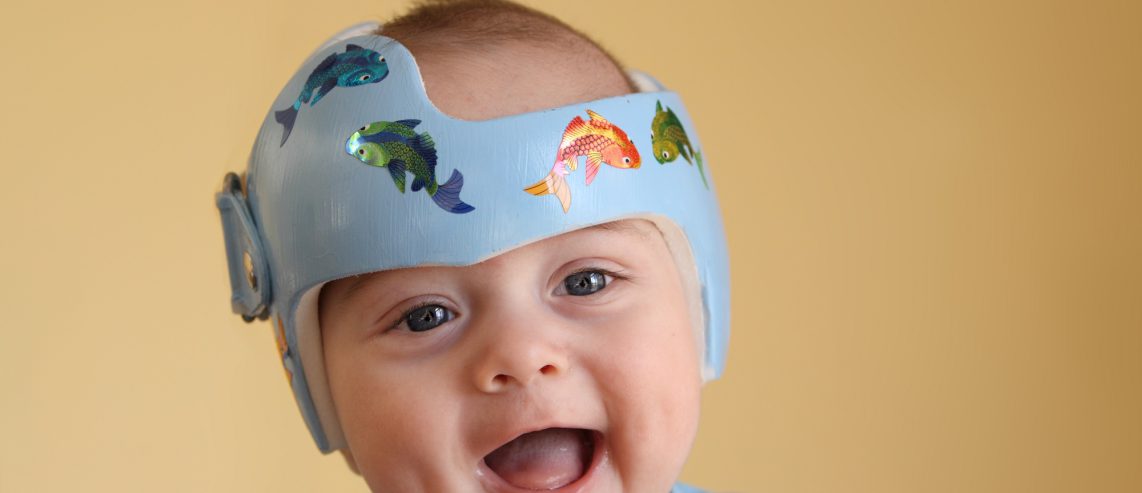Helmet therapy for correcting deformational plagiocephaly may strike some parents as scary. They may worry the helmet may make their baby uncomfortable or hinder their baby’s ability to eat, play, and explore their world.
Fortunately, helmet therapy is painless and safe. Babies are very adaptable, so they get used to wearing a helmet quickly.
A few months of helmet therapy can improve your child’s head shape for life.
Why Does My Child Need Helmet Therapy for
Some babies need helmets to make their heads more round and symmetrical if they have significant head shape issues referred to as deformational plagiocephaly. It’s common for babies to develop a flat spot on the back or side of their heads. This is typically due to a preferred head position during sleep and during use of car seats, swings, and bouncers. The persistent head position can result in the development of a flat spot on the back of the head.
This occurs because babies’ skulls have not fully formed — flexible fibers connect the bony plates of their skulls. This makes the baby’s head somewhat malleable and makes room for their fast-growing brain. Head size can triple over the first year of life. Over time, they can develop a flat spot if the same part of their head lies on a flat surface persistently.
Research indicates that almost half of babies have at least a mild flat spot at around 3 months of age.
Usually, these areas resolve without treatment if the flattening is mild, as babies spend more time on their tummies. But if a flat spot is prominent and doesn’t get better with more tummy time, your doctor may suggest a cranial molding helmet.
Doctors usually suggest helmets for babies between 4 and 8 months, according to the American Academy of Pediatrics. In general, the earlier a baby starts helmet therapy, the faster it’ll work. Experts in UPMC Children’s Hospital of Pittsburgh’s Division of Plastic Surgery recommend initiation of a molding helmet therapy prior to 6 months of age for the most improvement of head shape. Molding helmets work best at this early stage because babies’ skulls are more flexible when they’re younger.
In most cases, having a flat spot from a preferred position doesn’t pose any risk to a child’s health or growth. But parents often want to correct deformational plagiocephaly for cosmetic reasons.
Never Miss a Beat!
Subscribe to Our HealthBeat Newsletter!
Thank you for subscribing!
You can now select the specific newsletters you'd like to receive.
You are already subscribed.
Subscribe to more newsletters in our email preference center.
Sorry, an error occurred. Please try again later.
Get Healthy Tips Sent to Your Phone!
Different Types of Head Shape Differences
Your baby may need helmet therapy for the following reasons.
Deformational Plagiocephaly
Deformational plagiocephaly refers to a flat spot at the back of a child’s head that makes it asymmetrical. This can happen if a baby lies on their back too much, with their head slightly to the side.
Babies sometimes turn their heads to one side because they have weaker muscles on one side of their neck. This is referred to as torticollis. If this is the case with your baby, they may need physical therapy in addition to helmet therapy. If torticollis is recognized at an early age your baby’s head shape may improve without the need of helmet therapy. The physical therapist will work with parents to encourage babies to turn their heads using different positions and will recommend stretching exercises to be completed at home by the parents.
Brachycephaly
Brachycephaly is when the head is flat across the back of the head. This can occur if a baby often lies on their backs facing straight up. This can happen from lying in a crib, as well as reclining in a stroller, car seat, or baby swing.
NICUcephaly (dolichocephaly)
Premature babies can get a type of flat head syndrome called NICUcephaly or dolichocephaly. In neonatal intensive care units (NICUs), staff will often place babies on their sides to prevent reflux and breathing problems. This can cause a flat spot to form on the side of the head and result in a long narrow head shape.
Rare Causes of Plagiocephaly or a Flat Head
A rare congenital condition called craniosynostosis can also result in abnormal head shape. This occurs due the the absences or premature fusion of one of the skulls growth center referred to as sutures. In these cases, the baby may require surgical treatment to give the brain enough room to grow to improve the head shape.
Craniosynostosis occurs in approximately one in 2,000 babies. The diagnosis for this often occurs at birth.
Doctors treat craniosynostosis with surgery, helmet therapy, or both.
What to Expect With Helmet Therapy
If your baby has a persistent flat spot on their head or plagiocephaly which does not improve with repositioning and physical therapy, your doctor will refer you to an orthotic center. This center makes medical helmets for babies. On the first visit, you’ll meet the orthotist who specializes in cranial molding helmet therapy.
They’ll scan your baby’s head to create 3D images of your baby’s head. The scan uses light, not radiation. It’s safe and painless and takes less than a minute.
Based on the scan, the center will make a helmet tailored to your baby’s head shape and size.
For the helmet to work, your baby must wear it for 23 hours daily. During the hour you take off the helmet, you can bathe your baby and wash the helmet. The center that makes your helmet will instruct you on what soap to use and how to dry it.
Because of the shape and cushioning of the helmet, your baby’s skull will gradually become more rounded. This process happens even as your child lies in their preferred position.
How long your child needs a helmet will depend on their age and the degree and type of flatness or plagiocephaly. Your child may need a helmet for three to six months.
Getting Used to Helmet Therapy
Your baby may fuss a bit when getting used to the helmet. They may touch and pull at it and wake more often at night. Because the helmet traps heat, you may find your baby needs fewer layers or a cooler room temperature at night.
Most babies get used to the helmet within a few days. They’ll soon forget they have a helmet on.
The baby’s head may also show some red spots when you take off the helmet. If the red spots don’t go away after the helmet is removed or if you notice sores or skin issues, contact the orthotist as the helmet may require an adjustment.
Helmet Therapy Follow-Up Visits
You’ll have several follow-up visits at the orthotic center. They may take more scans to see how your baby’s head shape changes.
Your orthotist may need to adjust the helmet during these visits. They may also need to create a second helmet for your baby partway through in some cases.
One day, you’ll look back on the photos with pride at how you and your child made it through helmet therapy. Plus, with many fun designs and colors, your baby can stay as cute as ever.
Sources
American Academy of Pediatrics. Baby Helmet Therapy: Parent FAQs. Link
American Academy of Pediatrics. Identifying the Misshapen Head: Craniosynostosis and Related Disorders. Link
American Academy of Pediatrics. When a Baby's Head Is Misshapen: Positional Skull Deformities. Link
Adrienne Farr. Baby Helmet Therapy: What Parents Can Expect. Parents. Link
Dr. William Barrell et al. Identification of a novel variant of the ciliopathic gene FUZZY associated with craniosynostosis. European Society of Human Genetics. Link
International Society for Pediatric Neurologists. Epidemiology of Positional Plagiocephaly in Children. Link
McCarty DB, et al. Dolichocephaly in Preterm Infants: Prevalence, Risk Factors, and Early Motor Outcomes. American Journal of Perinatology. Link.
Wendy Wisner. What to Know About Dolichocephaly. Verywell Family Link
About Pediatrics
From nutrition to illnesses, from athletics to school, children will face many challenges growing up. Parents often will make important health care decisions for them. We hope to help guide both of you in that journey. UPMC Children’s Hospital of Pittsburgh is a national leader in pediatric care, ranking consistently on U.S. News & World Report’s Best Children’s Hospitals Honor Roll. We provide expert treatment for pediatric diseases, along well-child visits, urgent care, and more. With locations across Pennsylvania, Maryland, and West Virginia, you can find world-class care close to home. We also work closely with UPMC Magee-Womens Hospital, a national leader in care for newborns and their mothers. Our goal is to provide the best care for your children, from birth to adulthood and beyond. Visit our website to find a doctor near you.

